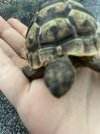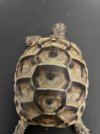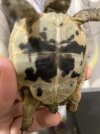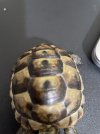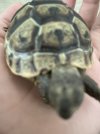I accidentally dropped my greek tortoises, (one 3 and one 4) and one of them has visible injury. It looks like the small part of the shell got chipped. The other one looks ok. I also noticed they made a squealing sound when i dropped them. And before you suggest that i should go to a reptile vet, there are none in my country.
You are using an out of date browser. It may not display this or other websites correctly.
You should upgrade or use an alternative browser.
You should upgrade or use an alternative browser.
Tortoise injury
- Thread starter Noyo
- Start date
-
- Tags
- shell damage
Alex and the Redfoot
Well-Known Member
Hello!I accidentally dropped my greek tortoises, (one 3 and one 4) and one of them has visible injury. It looks like the small part of the shell got chipped. The other one looks ok. I also noticed they made a squealing sound when i dropped them. And before you suggest that i should go to a reptile vet, there are none in my country.
A small chip, as I can see from the photo is not dangerous. If broken shell edge is sharp it can scab tortoise neck - watch for a few days for that. If there is blood - get Betadine (povidone-iodine) or chlorhexidine from pharmacy and apply it one time. Then apply antibiotic creme (like Neosporine) for a week. Don't use ethanol-iodine solution!
Also, try to make some more better photos of your tortoise shells (top and bottom) to see if there are any cracks. To make a photo of the bottom - carefully lift your tortoise, head up (ask someone to help you). Don't turn them on their back.
Watch closely if they have trouble walking or less active than usual. If your tortoises live outside - take the one with injured shell in the house and keep it for some days inside on paper towels in a box to prevent contamination of injury with fly eggs or bacteria.
Just in case, keep your tortoise in separate pens or enclosures. Living together in pair is stressful for them.
Littleredfootbigredheart
Well-Known Member
Hello and welcome to the forum! I’m sorry you’re joining under stressful circumstances😣try to follow Alex’s suggestions.
If they aren’t already, these two definitely need separating! tortoise of any species should NEVER be housed in pairs under any circumstances, they’re incredibly territorial, behaviours that look cute to us really aren’t, following one another and sleeping huddled up is all bullying the the tortoise world, you’ll eventually see more extreme signs of aggression. One can effect the others growth. Anyone who tells you pairs are fine, have no idea what they’re talking about.
Small groups can be kept when there’s acres for them to wonder and you have the correct male to female ratio.
These guys are going to need separating and put into separate appropriate enclosures.
As adults they need a minimum of an 8x4 enclosure, roaming is vital to tortoise health, it aids digestion and strengthen their muscles.
Don’t think they can get away with smaller if allowed to free roam, I’d highly discourage indoor free roams, being away from their heat source means they’re being exposed to temperatures that are too low quite often, smooth surfaces like laminate flooring will wreak absolute havoc on their hip joints over time.
There’s just numerous reasons it isn’t a good idea unfortunately, harmful floor cleaners, foreign objects being swallowed, getting stuck under things they shouldn’t like shelving or sofas, low temperatures, no uv, getting hit by doors, one member has mentioned they knew someone who’s tort got their head crushed in a door jam😣, flipping hazards, smooth services, the list goes on and is endless.
They feel most comfortable and safe in a space that best mimics their natural environment, so an appropriate sized enclosure is always the ultimate goal, hopefully we can help🥰
I’m going to include some information below on an example of an appropriate indoor set up, it includes the correct levels and equipment etc should you need to adjust anything.
This is one way to come up with an appropriate indoor set up, including the appropriate indoor uv, but if you have an outdoor enclosure they spend a few hours in daily(separately)you probably won’t need uv.
Basking light should be an incandescent floodlight(example attached) on a 12 hour timer.
Basking temperature directly under the floodlight should be 95-100f. The rest of the enclosure should be ranging 75-80 during the day.
You may also wish to add ambient lighting on the same timer, providing shady areas with hides and safe plants.
Then CHE/CHE’s(ceramic heat emitters) always on a thermostat, for night heat if your house drops below 60’s at night. Set the thermostat for a night temperature place the probe in their cooler end, plug the che into it and the thermostat into the mains, it’ll be plugged in 24/7 but will only turn on when the temperature drops.
Indoor Uv should be a t5 fluorescent tube, avoid the compact and coil uv bulbs, they don’t give out enough uv and can hurt the tortoises eyes. The uv can be on a 4 hour timer from noon. I’ve attached examples of the two brands to go for and some examples of how to mount them.
With lighting always avoid anything labelled halogen or mercury vapour.
For substrates, either coco coir, dampened and packed down by hand as a base, with a layer of orchid(fir not pine) bark or forest floor on top, or just the orchid bark/forest floor. Never use anything with sand mixed in, no top soils and no kinds of moss. The problem with top soil is unless you’ve composted it yourself, you don’t know what kind of plants have gone into it, it could be something toxic. Sand can irritate the eyes and be an impaction risk, moss is an impaction risk too.
You want to aim to have the bottom layer of substrate damp, to do this pour lukewarm water into the corners, not loads but enough to dampen the entire bottom layer. To stop that top layer getting a little too dry/dusty, mix the substrate now n then. Check your monitors and substrate to do the pours as and when needed.
I’d personally recommend you make your own base to go as big as you possibly can for the space you have, roaming room is vital for tortoise health, it aids in digestion and builds muscle strength. The closer you can get to an 8x4 size the better. If they have an outdoor enclosure they spend most their time, you’ll get away with a bit smaller inside, they need plenty of room to roam though.
When making your base, just make sure the material is safe, some use flower beds, or take a large bookcase, take out the shelves and lie flat, or just make their own, for all these options I’d line with cheap pond liner to protect the base, making sure the liner goes up the sides too and make sure those sides are deep enough! They can be professional escape artists😂
I’ve also included examples of stands people make/buy to hang their lighting, use a temperature gun to determine how high the basking bulb needs to be, the uv I suggested needs to be mounted 18-20 inches from the substrate.
For a water dish a shallow terracotta saucer is considered safest, they have grip in the event your tortoise flips themselves, most pet store options are a known hazard.
I’d also always recommend getting your hands on a temp gun, they’re SO handy when setting up a new environment or for checking your monitors are correct🙂
Also you may find this link below useful for some food ideas! You can buy seeds online and plant in organic soil(free of chemicals) in a planter the tortoises don’t have access to, and forage from them as they grow😊
If they aren’t already, these two definitely need separating! tortoise of any species should NEVER be housed in pairs under any circumstances, they’re incredibly territorial, behaviours that look cute to us really aren’t, following one another and sleeping huddled up is all bullying the the tortoise world, you’ll eventually see more extreme signs of aggression. One can effect the others growth. Anyone who tells you pairs are fine, have no idea what they’re talking about.
Small groups can be kept when there’s acres for them to wonder and you have the correct male to female ratio.
These guys are going to need separating and put into separate appropriate enclosures.
As adults they need a minimum of an 8x4 enclosure, roaming is vital to tortoise health, it aids digestion and strengthen their muscles.
Don’t think they can get away with smaller if allowed to free roam, I’d highly discourage indoor free roams, being away from their heat source means they’re being exposed to temperatures that are too low quite often, smooth surfaces like laminate flooring will wreak absolute havoc on their hip joints over time.
There’s just numerous reasons it isn’t a good idea unfortunately, harmful floor cleaners, foreign objects being swallowed, getting stuck under things they shouldn’t like shelving or sofas, low temperatures, no uv, getting hit by doors, one member has mentioned they knew someone who’s tort got their head crushed in a door jam😣, flipping hazards, smooth services, the list goes on and is endless.
They feel most comfortable and safe in a space that best mimics their natural environment, so an appropriate sized enclosure is always the ultimate goal, hopefully we can help🥰
I’m going to include some information below on an example of an appropriate indoor set up, it includes the correct levels and equipment etc should you need to adjust anything.
This is one way to come up with an appropriate indoor set up, including the appropriate indoor uv, but if you have an outdoor enclosure they spend a few hours in daily(separately)you probably won’t need uv.
Basking light should be an incandescent floodlight(example attached) on a 12 hour timer.
Basking temperature directly under the floodlight should be 95-100f. The rest of the enclosure should be ranging 75-80 during the day.
You may also wish to add ambient lighting on the same timer, providing shady areas with hides and safe plants.
Then CHE/CHE’s(ceramic heat emitters) always on a thermostat, for night heat if your house drops below 60’s at night. Set the thermostat for a night temperature place the probe in their cooler end, plug the che into it and the thermostat into the mains, it’ll be plugged in 24/7 but will only turn on when the temperature drops.
Indoor Uv should be a t5 fluorescent tube, avoid the compact and coil uv bulbs, they don’t give out enough uv and can hurt the tortoises eyes. The uv can be on a 4 hour timer from noon. I’ve attached examples of the two brands to go for and some examples of how to mount them.
With lighting always avoid anything labelled halogen or mercury vapour.
For substrates, either coco coir, dampened and packed down by hand as a base, with a layer of orchid(fir not pine) bark or forest floor on top, or just the orchid bark/forest floor. Never use anything with sand mixed in, no top soils and no kinds of moss. The problem with top soil is unless you’ve composted it yourself, you don’t know what kind of plants have gone into it, it could be something toxic. Sand can irritate the eyes and be an impaction risk, moss is an impaction risk too.
You want to aim to have the bottom layer of substrate damp, to do this pour lukewarm water into the corners, not loads but enough to dampen the entire bottom layer. To stop that top layer getting a little too dry/dusty, mix the substrate now n then. Check your monitors and substrate to do the pours as and when needed.
I’d personally recommend you make your own base to go as big as you possibly can for the space you have, roaming room is vital for tortoise health, it aids in digestion and builds muscle strength. The closer you can get to an 8x4 size the better. If they have an outdoor enclosure they spend most their time, you’ll get away with a bit smaller inside, they need plenty of room to roam though.
When making your base, just make sure the material is safe, some use flower beds, or take a large bookcase, take out the shelves and lie flat, or just make their own, for all these options I’d line with cheap pond liner to protect the base, making sure the liner goes up the sides too and make sure those sides are deep enough! They can be professional escape artists😂
I’ve also included examples of stands people make/buy to hang their lighting, use a temperature gun to determine how high the basking bulb needs to be, the uv I suggested needs to be mounted 18-20 inches from the substrate.
For a water dish a shallow terracotta saucer is considered safest, they have grip in the event your tortoise flips themselves, most pet store options are a known hazard.
I’d also always recommend getting your hands on a temp gun, they’re SO handy when setting up a new environment or for checking your monitors are correct🙂
Also you may find this link below useful for some food ideas! You can buy seeds online and plant in organic soil(free of chemicals) in a planter the tortoises don’t have access to, and forage from them as they grow😊
The Tortoise Table - Home
The Tortoise Table plant database and resource site for Tortoise owners
www.thetortoisetable.org.uk
Attachments
-
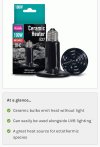 IMG_1684.jpeg147 KB · Views: 1
IMG_1684.jpeg147 KB · Views: 1 -
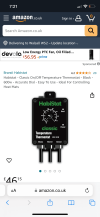 IMG_1679.png143.4 KB · Views: 1
IMG_1679.png143.4 KB · Views: 1 -
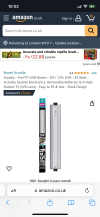 IMG_1683.png151.5 KB · Views: 1
IMG_1683.png151.5 KB · Views: 1 -
 IMG_1733.jpeg29.9 KB · Views: 1
IMG_1733.jpeg29.9 KB · Views: 1 -
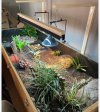 IMG_1871.jpeg238 KB · Views: 1
IMG_1871.jpeg238 KB · Views: 1 -
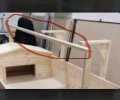 IMG_1670.jpeg65.1 KB · Views: 1
IMG_1670.jpeg65.1 KB · Views: 1 -
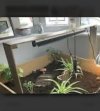 IMG_1672.jpeg84.7 KB · Views: 1
IMG_1672.jpeg84.7 KB · Views: 1 -
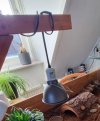 IMG_1872.jpeg48.1 KB · Views: 1
IMG_1872.jpeg48.1 KB · Views: 1 -
 IMG_1873.jpeg32 KB · Views: 1
IMG_1873.jpeg32 KB · Views: 1 -
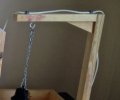 IMG_2028.jpeg10 KB · Views: 1
IMG_2028.jpeg10 KB · Views: 1 -
 IMG_2024.jpeg275.7 KB · Views: 1
IMG_2024.jpeg275.7 KB · Views: 1 -
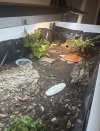 IMG_2023.jpeg376.2 KB · Views: 1
IMG_2023.jpeg376.2 KB · Views: 1 -
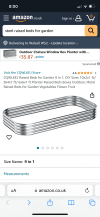 IMG_1628.png178.4 KB · Views: 1
IMG_1628.png178.4 KB · Views: 1
Thanks! They arent showing any signs of injury and im gong to get the materials you mentioned.Hello!
A small chip, as I can see from the photo is not dangerous. If broken shell edge is sharp it can scab tortoise neck - watch for a few days for that. If there is blood - get Betadine (povidone-iodine) or chlorhexidine from pharmacy and apply it one time. Then apply antibiotic creme (like Neosporine) for a week. Don't use ethanol-iodine solution!
Also, try to make some more better photos of your tortoise shells (top and bottom) to see if there are any cracks. To make a photo of the bottom - carefully lift your tortoise, head up (ask someone to help you). Don't turn them on their back.
Watch closely if they have trouble walking or less active than usual. If your tortoises live outside - take the one with injured shell in the house and keep it for some days inside on paper towels in a box to prevent contamination of injury with fly eggs or bacteria.
Just in case, keep your tortoise in separate pens or enclosures. Living together in pair is stressful for them.
Oh wow, i didnt know they should have been selected . Although i dont see any signs of aggression. And yes, i did do everything you mentioned, although the UV bulb broke so i ordered a new on, they have been without it for a while so i take them outside in the sun (with supervision)Hello and welcome to the forum! I’m sorry you’re joining under stressful circumstances😣try to follow Alex’s suggestions.
If they aren’t already, these two definitely need separating! tortoise of any species should NEVER be housed in pairs under any circumstances, they’re incredibly territorial, behaviours that look cute to us really aren’t, following one another and sleeping huddled up is all bullying the the tortoise world, you’ll eventually see more extreme signs of aggression. One can effect the others growth. Anyone who tells you pairs are fine, have no idea what they’re talking about.
Small groups can be kept when there’s acres for them to wonder and you have the correct male to female ratio.
These guys are going to need separating and put into separate appropriate enclosures.
As adults they need a minimum of an 8x4 enclosure, roaming is vital to tortoise health, it aids digestion and strengthen their muscles.
Don’t think they can get away with smaller if allowed to free roam, I’d highly discourage indoor free roams, being away from their heat source means they’re being exposed to temperatures that are too low quite often, smooth surfaces like laminate flooring will wreak absolute havoc on their hip joints over time.
There’s just numerous reasons it isn’t a good idea unfortunately, harmful floor cleaners, foreign objects being swallowed, getting stuck under things they shouldn’t like shelving or sofas, low temperatures, no uv, getting hit by doors, one member has mentioned they knew someone who’s tort got their head crushed in a door jam😣, flipping hazards, smooth services, the list goes on and is endless.
They feel most comfortable and safe in a space that best mimics their natural environment, so an appropriate sized enclosure is always the ultimate goal, hopefully we can help🥰
I’m going to include some information below on an example of an appropriate indoor set up, it includes the correct levels and equipment etc should you need to adjust anything.
This is one way to come up with an appropriate indoor set up, including the appropriate indoor uv, but if you have an outdoor enclosure they spend a few hours in daily(separately)you probably won’t need uv.
Basking light should be an incandescent floodlight(example attached) on a 12 hour timer.
Basking temperature directly under the floodlight should be 95-100f. The rest of the enclosure should be ranging 75-80 during the day.
You may also wish to add ambient lighting on the same timer, providing shady areas with hides and safe plants.
Then CHE/CHE’s(ceramic heat emitters) always on a thermostat, for night heat if your house drops below 60’s at night. Set the thermostat for a night temperature place the probe in their cooler end, plug the che into it and the thermostat into the mains, it’ll be plugged in 24/7 but will only turn on when the temperature drops.
Indoor Uv should be a t5 fluorescent tube, avoid the compact and coil uv bulbs, they don’t give out enough uv and can hurt the tortoises eyes. The uv can be on a 4 hour timer from noon. I’ve attached examples of the two brands to go for and some examples of how to mount them.
With lighting always avoid anything labelled halogen or mercury vapour.
For substrates, either coco coir, dampened and packed down by hand as a base, with a layer of orchid(fir not pine) bark or forest floor on top, or just the orchid bark/forest floor. Never use anything with sand mixed in, no top soils and no kinds of moss. The problem with top soil is unless you’ve composted it yourself, you don’t know what kind of plants have gone into it, it could be something toxic. Sand can irritate the eyes and be an impaction risk, moss is an impaction risk too.
You want to aim to have the bottom layer of substrate damp, to do this pour lukewarm water into the corners, not loads but enough to dampen the entire bottom layer. To stop that top layer getting a little too dry/dusty, mix the substrate now n then. Check your monitors and substrate to do the pours as and when needed.
I’d personally recommend you make your own base to go as big as you possibly can for the space you have, roaming room is vital for tortoise health, it aids in digestion and builds muscle strength. The closer you can get to an 8x4 size the better. If they have an outdoor enclosure they spend most their time, you’ll get away with a bit smaller inside, they need plenty of room to roam though.
When making your base, just make sure the material is safe, some use flower beds, or take a large bookcase, take out the shelves and lie flat, or just make their own, for all these options I’d line with cheap pond liner to protect the base, making sure the liner goes up the sides too and make sure those sides are deep enough! They can be professional escape artists😂
I’ve also included examples of stands people make/buy to hang their lighting, use a temperature gun to determine how high the basking bulb needs to be, the uv I suggested needs to be mounted 18-20 inches from the substrate.
For a water dish a shallow terracotta saucer is considered safest, they have grip in the event your tortoise flips themselves, most pet store options are a known hazard.
I’d also always recommend getting your hands on a temp gun, they’re SO handy when setting up a new environment or for checking your monitors are correct🙂
Also you may find this link below useful for some food ideas! You can buy seeds online and plant in organic soil(free of chemicals) in a planter the tortoises don’t have access to, and forage from them as they gr
I applied the chlorexidine to the injured tortoise, but ive noticed the other one has been sleeping for a while after the fall. Its still alive because it changed its position slightly, but i just want to know if the sleeping part is ok.Hello!
A small chip, as I can see from the photo is not dangerous. If broken shell edge is sharp it can scab tortoise neck - watch for a few days for that. If there is blood - get Betadine (povidone-iodine) or chlorhexidine from pharmacy and apply it one time. Then apply antibiotic creme (like Neosporine) for a week. Don't use ethanol-iodine solution!
Also, try to make some more better photos of your tortoise shells (top and bottom) to see if there are any cracks. To make a photo of the bottom - carefully lift your tortoise, head up (ask someone to help you). Don't turn them on their back.
Watch closely if they have trouble walking or less active than usual. If your tortoises live outside - take the one with injured shell in the house and keep it for some days inside on paper towels in a box to prevent contamination of injury with fly eggs or bacteria.
Just in case, keep your tortoise in separate pens or enclosures. Living together in pair is stressful for them.
Alex and the Redfoot
Well-Known Member
It may be just stressed out or in pain but also it can be something more serious. If there are red/orange/rose areas on its bottom shell - it's a bad sign. Please, post more photos of them as I asked before.I applied the chlorexidine to the injured tortoise, but ive noticed the other one has been sleeping for a while after the fall. Its still alive because it changed its position slightly, but i just want to know if the sleeping part is ok.
Should i wake the ones that are sleeping?It may be just stressed out or in pain but also it can be something more serious. If there are red/orange/rose areas on its bottom shell - it's a bad sign. Please, post more photos of them as I asked before.
Alex and the Redfoot
Well-Known Member
I would leave it sleeping. Unfortunately, if it's a lethal trauma we can't do much about it. If possible try to keep them warm at night (26-28C).Should i wake the ones that are sleeping?
It may be just stressed out or in pain but also it can be something more serious. If there are red/orange/rose areas on its bottom shell - it's a bad sign. Please, post more photos of them as I asked before.
Attachments
It woke up on its ownI would leave it sleeping. Unfortunately, if it's a lethal trauma we can't do much about it. If possible try to keep them warm at night (26-28C).
Alex and the Redfoot
Well-Known Member
That's a good signIt woke up on its own
If you have to move them around, you can do that in a small plastic box or tub so they are less stressed and wouldn't slip out of your hands.
Watch them for a few days - if there are any troubles walking, eating, pulling head in the shell. Check their bottom shells daily. And just a reminder - pay attention to the neck skin of tortoises with chipped shell. If shell edge will rub against neck, you may need to file the sharp edge.
Keep us updated, anyway!
Littleredfootbigredheart
Well-Known Member
Yeah even without obvious signs of aggression I’d bet them separated.Oh wow, i didnt know they should have been selected . Although i dont see any signs of aggression. And yes, i did do everything you mentioned, although the UV bulb broke so i ordered a new on, they have been without it for a while so i take them outside in the sun (with supervision)
Wishing you all the best and I hope your little guy recovers for you❤️
Thank you!!Yeah even without obvious signs of aggression I’d bet them separated.
Wishing you all the best and I hope your little guy recovers for you❤️
I will!That's a good signPhotos are blurry, but I see nothing concerning - cracks, bruises and such.
If you have to move them around, you can do that in a small plastic box or tub so they are less stressed and wouldn't slip out of your hands.
Watch them for a few days - if there are any troubles walking, eating, pulling head in the shell. Check their bottom shells daily. And just a reminder - pay attention to the neck skin of tortoises with chipped shell. If shell edge will rub against neck, you may need to file the sharp edge.
Keep us updated, anyway!
Littleredfootbigredheart
Well-Known Member
So glad they’re getting better❤️Its healing ❤️🩹
